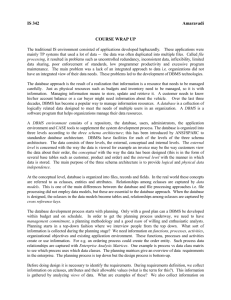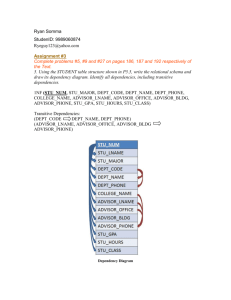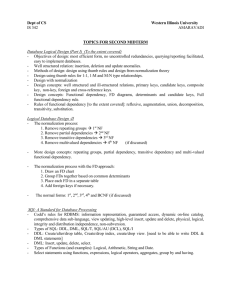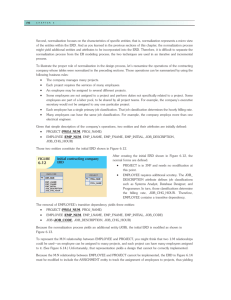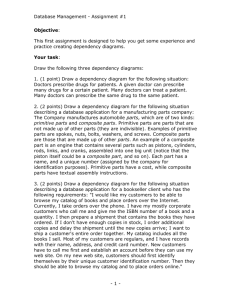Lecture 7 - e-learning website
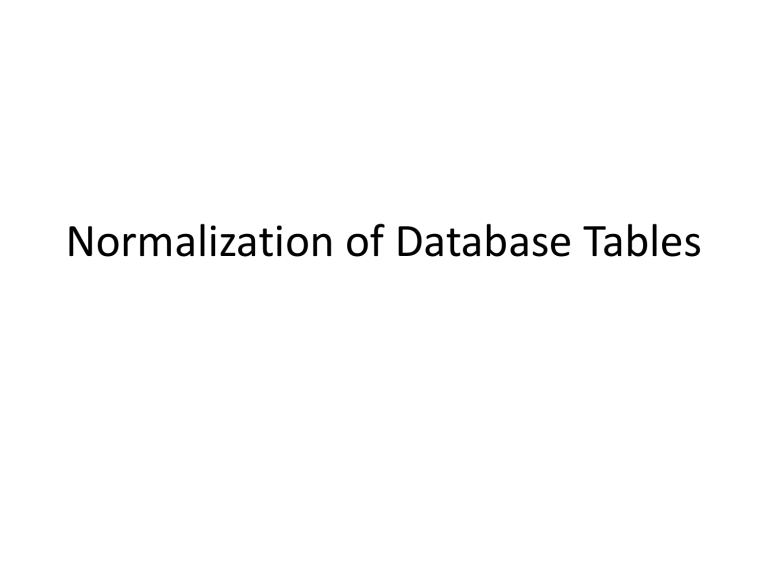
Normalization of Database Tables
•
Normalization is a process for evaluating and correcting table structures to minimize data redundancies, thereby reducing the likelihood of data anomalies.
•
The normalization process involves assigning attributes to tables based on the concept of determination
• Normalization works through a series of stages called normal forms.
• The first three stages are described as first normal form
(1NF), second normal form (2NF), and third normal form (3NF).
• From a structural point of view, 2NF is better than 1NF, and 3NF is better than 2NF.
• For most purposes in business database design, 3NF is as high as you need to go in the normalization process.
• However, you will discover that properly designed 3NF structures also meet the requirements of fourth normal form (4NF).
• Although normalization is a very important database design ingredient, you should not assume that the highest level of normalization is always the most desirable.
• Generally, the higher the normal form, the more relational join operations are required to produce a specified output and the more resources are required by the database system to respond to enduser queries.
• A successful design must also consider end-user demand for fast performance.
• Therefore, you will occasionally be expected to denormalize some portions of a database design in order to meet performance requirements.
• Denormalization produces a lower normal form; that is, a 3NF will be converted to a 2NF through denormalization.
• However, the price you pay for increased performance through
denormalization is greater data redundancy.
Note
• Although the word table is used throughout this chapter, formally, normalization is concerned with relations.
• You learned that the terms table and relation are frequently used interchangeably.
• In fact, you can say that a table is the implementation view of a logical relation that meets some specific conditions.
• However, being more rigorous, the mathematical relation does not allow duplicate tuples, whereas duplicate tuples could exist in tables.
• Also, in normalization terminology, any attribute that is at least part of a key is known as a prime attribute instead of the more common term key attribute, which was introduced earlier.
• Conversely, a nonprime attribute, or a nonkey attribute, is not part of any candidate key.
THE NEED FOR NORMALIZATION
• Normalization is typically used in conjunction with the entity relationship modeling.
• There are two common situations in which database designers use normalization.
• When designing a new database structure based on the business requirements of the end users, the database designer will construct a data model using a technique such as Crow’s Foot notation ERDs.
• After the initial design is complete, the designer can use normalization to analyze the relationships that exist among the attributes within each entity, to determine if the structure can be improved through normalization.
• Alternatively, database designers are often asked to modify existing data structures that can be in the form of flat files, spreadsheets, or older database structures.
• Again, through an analysis of the relationships among the attributes or fields in the data structure, the database designer can use the normalization process to improve the existing data structure to create an appropriate database design.
• Whether designing a new database structure or modifying an existing one, the normalization process is the same.
• To get a better idea of the normalization process, consider the simplified database activities of a construction company that manages several building projects.
• Each project has its own project number, name, employees assigned to it, and so on.
• Each employee has an employee number, name, and job classification, such as engineer or computer technician.
• The company charges its clients by billing the hours spent on each contract.
• The hourly billing rate is dependent on the employee’s position.
• For example, one hour of computer technician time is billed at a different rate than one hour of engineer time.
• Periodically, a report is generated that contains the information displayed.
• The total charge is a derived attribute and, at this point, is not stored in the table.
• The easiest short-term way to generate the required report might seem to be a table whose contents correspond to the reporting requirements.
• Note that the data in Figure 6.1 reflect the assignment of employees to projects.
• Apparently, an employee can be assigned to more than one project.
• For example, Darlene Smithson (EMP_NUM = 112) has been assigned to two projects: Amber Wave and Starflight. Given the structure of the dataset, each project includes only a single occurrence of any one employee.
• Therefore, knowing the PROJ_NUM and EMP_NUM value will let you find the job classification and its hourly charge.
• In addition, you will know the total number of hours each employee worked on each project.
• (The total charge—a derived attribute whose value can be computed by multiplying the hours billed and the charge per hour—has not been included in Figure 6.1. No structural harm is done if this derived attribute is included.)
• Unfortunately, the structure of the dataset in Figure 6.1 does not conform to the requirements discussed earlier, nor does it handle data very well.
• Consider the following deficiencies:
– 1. The project number (PROJ_NUM) is apparently intended to be a primary key or at least a part of a PK, but it contains nulls. (Given the preceding discussion, you know that PROJ_NUM + EMP_NUM will define each row.)
– 2. The table entries invite data inconsistencies. For example, the JOB_CLASS value “Elect. Engineer” might be entered as “Elect.Eng.” in some cases, “El. Eng.” in others, and “EE” in still others.
• 3. The table displays data redundancies. Those data redundancies yield the following anomalies:
– a. Update anomalies. Modifying the JOB_CLASS for employee number 105 requires (potentially) many alterations, one for each EMP_NUM = 105.
– b. Insertion anomalies. Just to complete a row definition, a new employee must be assigned to a project. If the employee is not yet assigned, a phantom project must be created to complete the employee data entry.
– c. Deletion anomalies. Suppose that only one employee is associated with a given project. If that employee leaves the company and the employee data are deleted, the project information will also be deleted. To prevent the loss of the project information, a fictitious employee must be created just to save the project information.
• In spite of those structural deficiencies, the table structure appears to work; the report is generated with ease.
• Unfortunately, the report might yield varying results depending on what data anomaly has occurred.
• For example, if you want to print a report to show the total “hours worked” value by the job classification
“Database Designer,” that report will not include data for “DB Design” and “Database Design” data entries.
• Such reporting anomalies cause a multitude of problems for managers—and cannot be fixed through applications programming.
• Even if very careful data-entry auditing can eliminate most of the reporting problems (at a high cost), it is easy to demonstrate that even a simple data entry becomes inefficient.
• Given the existence of update anomalies, suppose Darlene M.
Smithson is assigned to work on the Evergreen project.
• The data-entry clerk must update the PROJECT file with the entry:
• 15 Evergreen 112 Darlene M Smithson DSS Analyst $45.95 0.0
• to match the attributes PROJ_NUM, PROJ_NAME, EMP_NUM,
EMP_NAME, JOB_CLASS, CHG_HOUR, and HOURS. (When Ms.
Smithson has just been assigned to the project, she has not yet worked, so the total number of hours worked is 0.0.)
Note
• Remember that the naming convention makes it easy to see what each attribute stands for and what its likely origin is.
• For example, PROJ_NAME uses the prefix PROJ to indicate that the attribute is associated with the
PROJECT table, while the NAME component is selfdocumenting, too.
• However, keep in mind that name length is also an issue, especially in the prefix designation.
• For that reason, the prefix CHG was used rather than
CHARGE. (Given the database’s context, it is not likely that that prefix will be misunderstood.)
• Each time another employee is assigned to a project, some data entries (such as PROJ_NAME, EMP_NAME, and CHG_HOUR) are unnecessarily repeated.
• Imagine the data-entry chore when 200 or 300 table entries must be made!
• Note that the entry of the employee number should be sufficient to identify Darlene M. Smithson, her job description, and her hourly charge.
• Because there is only one person identified by the number 112, that person’s characteristics (name, job classification, and so on) should not have to be typed in each time the main file is updated.
• Unfortunately, the structure displayed in Figure 6.1 does not make allowances for that possibility.
• The data redundancy evident in Figure 6.1 leads to wasted disk space.
• What’s more, data redundancy produces data anomalies. For example, suppose the data-entry clerk had entered the data as:
• 15 Evergeen 112 Darla Smithson DCS Analyst $45.95 0.0
• At first glance, the data entry appears to be correct. But is Evergeen the same project as Evergreen? And is DCS Analyst supposed to be
DSS Analyst? Is Darla Smithson the same person as Darlene M.
Smithson? Such confusion is a data integrity problem that was caused because the data entry failed to conform to the rule that all copies of redundant data must be identical.
• The possibility of introducing data integrity problems caused by data redundancy must be considered when a database is designed.
• The relational database environment is especially well suited to help the designer overcome those problems.
THE NORMALIZATION PROCESS
• The objective of normalization is to ensure that each table conforms to the concept of well-formed relations—that is, tables that have the following characteristics:
– Each table represents a single subject. For example, a course table will contain only data that directly pertain to courses. Similarly, a student table will contain only student data.
– No data item will be unnecessarily stored in more than one table (in short, tables have minimum controlled redundancy). The reason for this requirement is to ensure that the data are updated in only one place.
– All nonprime attributes in a table are dependent on the primary key— the entire primary key and nothing but the primary key. The reason for this requirement is to ensure that the data are uniquely identifiable by a primary key value.
– Each table is void of insertion, update, or deletion anomalies. This is to ensure the integrity and consistency of the data.
•
To accomplish the objective, the normalization process takes you through the steps that lead to successively higher normal forms. The most common normal forms and their basic characteristic are listed in Table 6.2.
• The concept of keys is central to the discussion of normalization.
• Recall that a candidate key is a minimal (irreducible) superkey.
• The primary key is the candidate key that is selected to be the primary means used to identify the rows in the table.
• Although normalization is typically presented from the perspective of candidate keys, for the sake of simplicity while initially explaining the normalization process, we will make the assumption that for each table there is only one candidate key, and therefore, that candidate key is the primary key.
• From the data modeler’s point of view, the objective of normalization is to ensure that all tables are at least in third normal form (3NF). Even higher-level normal forms exist.
• However, normal forms such as the fifth normal form
(5NF) and domain-key normal form (DKNF) are not likely to be encountered in a business environment and are mainly of theoretical interest.
• More often than not, such higher normal forms increase joins (slowing performance) without adding any value in the elimination of data redundancy.
• Some very specialized applications, such as statistical research, might require normalization beyond the 4NF, but those applications fall outside the scope of most business operations.
Functional Dependence
• It is crucial to understand these concepts because they are used to derive the set of functional dependencies for a given relation.
• The normalization process works one relation at a time, identifying the dependencies on that relation and normalizing the relation.
• As you will see in the following sections, normalization starts by identifying the dependencies of a given relation and progressively breaking up the relation
(table) into a set of new relations (tables) based on the identified dependencies.
• Two types of functional dependencies that are of special interest in normalization are partial dependencies and transitive dependencies.
• A partial dependency exists when there is a functional dependence in which the determinant is only part of the primary key (remember we are assuming there is only one candidate key).
• For example, if (A, B) → (C,D), B → C, and (A, B) is the primary key, then the functional dependence B → C is a partial dependency because only part of the primary key
(B) is needed to determine the value of C.
• Partial dependencies tend to be rather straightforward and easy to identify.
• A transitive dependency exists when there are functional dependencies such that X → Y, Y → Z, and X is the primary key.
• In that case, the dependency X → Z is a transitive dependency because X determines the value of Z via Y.
• Unlike partial dependencies, transitive dependencies are more difficult to identify among a set of data.
• Fortunately, there is an easier way to identify transitive dependencies.
• A transitive dependency will occur only when a functional dependence exists among nonprime attributes.
• In the previous example, the actual transitive dependency is X → Z.
• However, the dependency Y → Z signals that a transitive dependency exists.
• Hence, throughout the discussion of the normalization process, the existence of a functional dependence among nonprime attributes will be considered a sign of a transitive dependency.
• To address the problems related to transitive dependencies, changes to the table structure are made based on the functional dependence that signals the transitive dependency’s existence.
• Therefore, to simplify the description of normalization, from this point forward we will refer to the signaling dependency as the transitive dependency.
Conversion to First Normal Form
• Because the relational model views data as part of a table or a collection of tables in which all key values must be identified, the data depicted in Figure 6.1 might not be stored as shown.
• Note that Figure 6.1 contains what is known as repeating groups.
• A repeating group derives its name from the fact that a group of multiple entries of the same type can exist for any single key attribute occurrence.
• In Figure 6.1, note that each single project number (PROJ_NUM) occurrence can reference a group of related data entries.
• For example, the Evergreen project (PROJ_NUM = 15) shows five entries at this point—and those entries are related because they each share the PROJ_NUM = 15 characteristic.
• Each time a new record is entered for the Evergreen project, the number of entries in the group grows by one.
• A relational table must not contain repeating groups.
• The existence of repeating groups provides evidence that the
RPT_FORMAT table in Figure 6.1 fails to meet even the lowest normal form requirements, thus reflecting data redundancies.
• Normalizing the table structure will reduce the data redundancies.
• If repeating groups do exist, they must be eliminated by making sure that each row defines a single entity.
• In addition, the dependencies must be identified to diagnose the normal form.
• Identification of the normal form will let you know where you are in the normalization process.
• The normalization process starts with a simple three-step procedure.
Step 1: Eliminate the Repeating Groups
•
Start by presenting the data in a tabular format, where each cell has a single value and there are no repeating groups.
•
To eliminate the repeating groups, eliminate the nulls by making sure that each repeating group attribute contains an appropriate data value.
•
That change converts the table in Figure 6.1 to
1NF in Figure 6.2.
Step 2: Identify the Primary Key
• The layout in Figure 6.2 represents more than a mere cosmetic change.
• Even a casual observer will note that PROJ_NUM is not an adequate primary key because the project number does not uniquely identify all of the remaining entity (row) attributes.
• For example, the PROJ_NUM value 15 can identify any one of five employees.
• To maintain a proper primary key that will uniquely identify any attribute value, the new key must be composed of a combination of
PROJ_NUM and EMP_NUM.
• For example, using the data shown in Figure 6.2, if you know that
PROJ_NUM = 15 and EMP_NUM = 103, the entries for the attributes PROJ_NAME, EMP_NAME, JOB_CLASS, CHG_HOUR, and
HOURS must be Evergreen, June E. Arbough, Elect. Engineer,
$84.50, and 23.8, respectively.
Step 3: Identify All Dependencies
• The identification of the PK in Step 2 means that you have already identified the following dependency:
• PROJ_NUM, EMP_NUM → PROJ_NAME, EMP_NAME, JOB_CLASS,
CHG_HOUR, HOURS
• That is, the PROJ_NAME, EMP_NAME, JOB_CLASS, CHG_HOUR, and
HOURS values are all dependent on—that is, they are determined by—the combination of PROJ_NUM and EMP_NUM.
• There are additional dependencies. For example, the project number identifies (determines) the project name. In other words, the project name is dependent on the project number. You can write that dependency as:
• PROJ_NUM → PROJ_NAME
• Also, if you know an employee number, you also know that employee’s name, that employee’s job classification, and that employee’s charge per hour.
Therefore, you can identify the dependency shown next:
• EMP_NUM → EMP_NAME, JOB_CLASS, CHG_HOUR
• However, given the previous dependency components, you can see that knowing the job classification means knowing the charge per hour for that job classification.
In other words, you can identify one last dependency:
• JOB_CLASS → CHG_HOUR
• This dependency exists between two nonprime attributes; therefore it is a signal that a transitive dependency exists, and we will refer to it as a transitive dependency.
• The dependencies you have just examined can also be depicted with the help of the diagram shown in Figure 6.3.
• Because such a diagram depicts all dependencies found within a given table structure, it is known as a dependency
diagram.
• Dependency diagrams are very helpful in getting a bird’seye view of all of the relationships among a table’s attributes, and their use makes it less likely that you will overlook an important dependency.
• As you examine Figure 6.3, note the following dependency diagram features:
– 1. The primary key attributes are bold, underlined, and shaded in a different color.
– 2. The arrows above the attributes indicate all desirable dependencies, that is, dependencies that are based on the primary key. In this case, note that the entity’s attributes are dependent on the combination of PROJ_NUM and EMP_NUM.
– 3. The arrows below the dependency diagram indicate less desirable dependencies. Two types of such dependencies exist:
• a. Partial dependencies. You need to know only the PROJ_NUM to determine the PROJ_NAME; that is, the PROJ_NAME is dependent on only part of the primary key. And you need to know only the EMP_NUM to find the EMP_NAME, the JOB_CLASS, and the CHG_HOUR. A dependency based on only a part of a composite primary key is a partial dependency.
• b. Transitive dependencies. Note that CHG_HOUR is dependent on
JOB_CLASS. Because neither CHG_HOUR nor JOB_CLASS is a prime attribute—that is, neither attribute is at least part of a key—the condition is a transitive dependency. In other words, a transitive dependency is a dependency of one nonprime attribute on another nonprime attribute.
The problem with transitive dependencies is that they still yield data anomalies.
Note
• Figure 6.3 includes the relational schema for the table in 1NF and a textual notation for each identified dependency.
• The term first normal form (1NF) describes the tabular format in which:
– All of the key attributes are defined.
– There are no repeating groups in the table. In other words, each row/column intersection contains one and only one value, not a set of values.
– All attributes are dependent on the primary key.
• All relational tables satisfy the 1NF requirements.
• The problem with the 1NF table structure shown in Figure 6.3 is that it contains partial dependencies—that is, dependencies based on only a part of the primary key.
• While partial dependencies are sometimes used for performance reasons, they should be used with caution. (If the information requirements seem to dictate the use of partial dependencies, it is time to evaluate the need for a data warehouse design
• Such caution is warranted because a table that contains partial dependencies is still subject to data redundancies, and therefore, to various anomalies.
• The data redundancies occur because every row entry requires duplication of data.
• For example, if Alice K. Johnson submits her work log, then the user would have to make multiple entries during the course of a day.
• For each entry, the EMP_NAME, JOB_CLASS, and CHG_HOUR must be entered each time, even though the attribute values are identical for each row entered.
• Such duplication of effort is very inefficient.
• What’s more, the duplication of effort helps create data anomalies; nothing prevents the user from typing slightly different versions of the employee name, the position, or the hourly pay.
• For instance, the employee name for EMP_NUM = 102 might be entered as Dave Senior or D. Senior.
• The project name might also be entered correctly as Evergreen or misspelled as Evergeen.
• Such data anomalies violate the relational database’s integrity and consistency rules.
Conversion to Second Normal Form
•
Converting to 2NF is done only when the 1NF has a composite primary key.
•
If the 1NF has a single-attribute primary key, then the table is automatically in 2NF.
•
The 1NF-to-2NF conversion is simple.
•
Starting with the 1NF format displayed in
Figure 6.3, you do the following:
Step 1: Make New Tables to Eliminate
Partial Dependencies
• For each component of the primary key that acts as a determinant in a partial dependency, create a new table with a copy of that component as the primary key.
• While these components are placed in the new tables, it is important that they also remain in the original table as well.
• It is important that the determinants remain in the original table because they will be the foreign keys for the relationships that are needed to relate these new tables to the original table.
• For the construction of our revised dependency diagram, write each key component on a separate line; then write the original (composite) key on the last line. For example:
• PROJ_NUM
• EMP_NUM
• PROJ_NUM EMP_NUM
• Each component will become the key in a new table. In other words, the original table is now divided into three tables (PROJECT, EMPLOYEE, and
ASSIGNMENT).
Step 2: Reassign Corresponding
Dependent Attributes
• Use Figure 6.3 to determine those attributes that are dependent in the partial dependencies.
• The dependencies for the original key components are found by examining the arrows below the dependency diagram shown in
Figure 6.3.
• The attributes that are dependent in a partial dependency are removed from the original table and placed in the new table with its determinant.
• Any attributes that are not dependent in a partial dependency will remain in the original table.
• In other words, the three tables that result from the conversion to
2NF are given appropriate names (PROJECT, EMPLOYEE, and
ASSIGNMENT) and are described by the following relational schemas:
• PROJECT (PROJ_NUM, PROJ_NAME)
• EMPLOYEE (EMP_NUM, EMP_NAME, JOB_CLASS, CHG_HOUR)
• ASSIGNMENT (PROJ_NUM, EMP_NUM, ASSIGN_HOURS)
• Because the number of hours spent on each project by each employee is dependent on both PROJ_NUM and EMP_NUM in the
ASSIGNMENT table, you leave those hours in the ASSIGNMENT table as ASSIGN_HOURS.
• Notice that the ASSIGNMENT table contains a composite primary key composed of the attributes PROJ_NUM and EMP_NUM. Notice that by leaving the determinants in the original table as well as making them the primary keys of the new tables, primary key/foreign key relationships have been created. F
• or example, in the EMPLOYEE table,
• EMP_NUM is the primary key.
• In the ASSIGNMENT table, EMP_NUM is part of the composite primary key
• (PROJ_NUM, EMP_NUM) and is a foreign key relating the
EMPLOYEE table to the ASSIGNMENT table.
• The results of Steps 1 and 2 are displayed in Figure 6.4.
• At this point, most of the anomalies discussed earlier have been eliminated.
• For example, if you now want to add, change, or delete a PROJECT record, you need to go only to the PROJECT table and make the change to only one row.
• Because a partial dependency can exist only when a table’s primary key is composed of several attributes, a table whose primary key consists of only a single attribute is automatically in 2NF once it is in
1NF.
• Figure 6.4 still shows a transitive dependency, which can generate anomalies. For example, if the charge per hour changes for a job classification held by many employees, that change must be made for each of those employees.
• you forget to update some of the employee records that are affected by the charge per hour change, different employees with the same job description will generate different hourly charges.
Note
• A table is in second normal form (2NF) when:
– It is in 1NF.
– and
– It includes no partial dependencies; that is, no attribute is dependent on only a portion of the primary key.
• Note that it is still possible for a table in 2NF to exhibit transitive dependency; that is, the primary key may rely on one or more nonprime attributes to functionally determine other nonprime attributes, as is indicated by a functional dependence among the nonprime attributes.
Conversion to Third Normal Form
•
The data anomalies created by the database organization shown in Figure 6.4 are easily eliminated by completing the following two steps:
Step 1: Make New Tables to Eliminate
Transitive Dependencies
• For every transitive dependency, write a copy of its determinant as a primary key for a new table.
• A determinant is any attribute whose value determines other values within a row.
• If you have three different transitive dependencies, you will have three different determinants.
• As with the conversion to 2NF, it is important that the determinant remain in the original table to serve as a foreign key.
• Figure 6.4 shows only one table that contains a transitive dependency.
• Therefore, write the determinant for this transitive dependency as: JOB_CLASS
Step 2: Reassign Corresponding
Dependent Attributes
• Using Figure 6.4, identify the attributes that are dependent on each determinant identified in Step 1.
• Place the dependent attributes in the new tables with their determinants and remove them from their original tables.
• In this example, eliminate CHG_HOUR from the EMPLOYEE table shown in Figure 6.4 to leave the EMPLOYEE table dependency definition as:
• EMP_NUM → EMP_NAME, JOB_CLASS
• Draw a new dependency diagram to show all of the tables you have defined in Steps 1 and 2.
• Name the table to reflect its contents and function.
• In this case, JOB seems appropriate.
• Check all of the tables to make sure that each table has a determinant and that no table contains inappropriate dependencies.
• When you have completed these steps, you will see the results in
Figure 6.5.
• In other words, after the 3NF conversion has been completed, your database will contain four tables:
• PROJECT (PROJ_NUM, PROJ_NAME)
• EMPLOYEE (EMP_NUM, EMP_NAME, JOB_CLASS)
• JOB (JOB_CLASS, CHG_HOUR)
• ASSIGNMENT (PROJ_NUM, EMP_NUM,
ASSIGN_HOURS)
• Note that this conversion has eliminated the original
EMPLOYEE table’s transitive dependency; the tables are now said to be in third normal form (3NF).
Note
•
A table is in third normal form (3NF) when:
–
It is in 2NF.
– and
–
It contains no transitive dependencies.
• It is interesting to note the similarities between resolving 2NF and
3NF problems.
• To convert a table from 1NF to 2NF, it is necessary to remove the partial dependencies.
• To convert a table from 2NF to 3NF, it is necessary to remove the transitive dependencies.
• No matter whether the “problem” dependency is a partial dependency or a transitive dependency, the solution is the same.
• Create a new table for each problem dependency.
• The determinant of the problem dependency remains in the original table and is placed as the primary key of the new table.
• The dependents of the problem dependency are removed from the original table and placed as nonprime attributes in the new table.
• Be aware, however, that while the technique is the same, it is imperative that 2NF be achieved before moving on to 3NF; be certain to resolve the partial dependencies before resolving the transitive dependencies.
• Recall, however, the assumption that was made at the beginning of the discussion of the normalization process—that each table has only one candidate key, which is the primary key.
• If a table has multiple candidate keys, then the overall process remains the same, but there are additional considerations.
• For example, if a table has multiple candidate keys and one of those candidate keys is a composite key, the table can have partial dependencies based on this composite candidate key, even when the primary key chosen is a single attribute.
• In those cases, following the process described above, those dependencies would be perceived as transitive dependencies and would not be resolved until 3NF.
• The simplified process described above will allow the designer to achieve the correct result, but through practice, you should recognize all candidate keys and their dependencies as such, and resolve them appropriately.
• The existence of multiple candidate keys can also influence the identification of transitive dependencies.
• Previously, a transitive dependency was defined to exist when one nonprime attribute determined another nonprime attribute.
• In the presence of multiple candidate keys, the definition of a nonprime attribute as an attribute that is not a part of any candidate key is critical.
• If the determinant of a functional dependence is not the primary key but is a part of another candidate key, then it is not a nonprime attribute and does not signal the presence of a transitive dependency.
IMPROVING THE DESIGN
• The table structures are cleaned up to eliminate the troublesome partial and transitive dependencies.
• You can now focus on improving the database’s ability to provide information and on enhancing its operational characteristics.
• In the next few paragraphs, you will learn about the various types of issues you need to address to produce a good normalized set of tables.
• Please note that for space issues, each section presents just one example—the designer must apply the principle to all remaining tables in the design.
• Remember that normalization cannot, by itself, be relied on to make good designs.
• Instead, normalization is valuable because its use helps eliminate data redundancies.
Evaluate PK Assignments
• Each time a new employee is entered into the
EMPLOYEE table, a JOB_CLASS value must be entered.
• Unfortunately, it is too easy to make data-entry errors that lead to referential integrity violations.
• For example, entering DB Designer instead of Database
Designer for the JOB_CLASS attribute in the EMPLOYEE table will trigger such a violation.
• Therefore, it would be better to add a JOB_CODE attribute to create a unique identifier. The addition of a
JOB_CODE attribute produces the dependency:
• JOB_CODE → JOB_CLASS, CHG_HOUR
• If you assume that the JOB_CODE is a proper primary key, this new attribute does produce the dependency:
• JOB_CLASS → CHG_HOUR
• However, this dependency is not a transitive dependency because the determinant is a candidate key.
• Further, the presence of JOB_CODE greatly decreases the likelihood of referential integrity violations.
• Note that the new JOB table now has two candidate keys—JOB_CODE and
JOB_CLASS.
• In this case, JOB_CODE is the chosen primary key as well as a surrogate key.
• A surrogate key, as you should recall, is an artificial PK introduced by the designer with the purpose of simplifying the assignment of primary keys to tables.
• Surrogate keys are usually numeric, they are often automatically generated by the DBMS, they are free of semantic content (they have no special meaning), and they are usually hidden from the end users.
Evaluate Naming Conventions
• It is best to adhere to the naming conventions outlined earlier, Data Models.
• Therefore, CHG_HOUR will be changed to JOB_CHG_HOUR to indicate its association with the JOB table.
• In addition, the attribute name JOB_CLASS does not quite describe entries such as Systems Analyst, Database
Designer, and so on; the label JOB_DESCRIPTION fits the entries better.
• Also, you might have noticed that HOURS was changed to
ASSIGN_HOURS in the conversion from 1NF to 2NF.
• That change lets you associate the hours worked with the
ASSIGNMENT table.
Refine Attribute Atomicity
• It is generally good practice to pay attention to the atomicity requirement.
• An atomic attribute is one that cannot be further subdivided. Such an attribute is said to display atomicity.
• Clearly, the use of the EMP_NAME in the EMPLOYEE table is not atomic because EMP_NAME can be decomposed into a last name, a first name, and an initial.
• By improving the degree of atomicity, you also gain querying flexibility.
• For example, if you use EMP_LNAME, EMP_FNAME, and
EMP_INITIAL, you can easily generate phone lists by sorting last names, first names, and initials.
• Such a task would be very difficult if the name components were within a single attribute.
• In general, designers prefer to use simple, single-valued attributes as indicated by the business rules and processing requirements.
Identify New Attributes
• If the EMPLOYEE table were used in a real-world environment, several other attributes would have to be added.
• For example, year-to-date gross salary payments, Social
Security payments, and Medicare payments would be desirable.
• An employee hire date attribute (EMP_HIREDATE) could be used to track an employee’s job longevity and serve as a basis for awarding bonuses to long-term employees and for other morale-enhancing measures.
• The same principle must be applied to all other tables in your design.
Identify New Relationships
• According to the original report, the users need to track which employee is acting as the manager of each project.
• This can be implemented as a relationship between EMPLOYEE and
PROJECT.
• From the original report, it is clear that each project has only one manager.
• Therefore, the system’s ability to supply detailed information about each project’s manager is ensured by using the EMP_NUM as a foreign key in PROJECT.
• That action ensures that you can access the details of each
PROJECT’s manager data without producing unnecessary and undesirable data duplication.
• The designer must take care to place the right attributes in the right tables by using normalization principles.
Refine Primary Keys as Required for
Data Granularity
• Granularity refers to the level of detail represented by the values stored in a table’s row.
• Data stored at their lowest level of granularity are said to be atomic data, as explained earlier.
• In Figure 6.5, the ASSIGNMENT table in 3NF uses the
ASSIGN_HOURS attribute to represent the hours worked by a given employee on a given project.
• However, are those values recorded at their lowest level of granularity? In other words, does
ASSIGN_HOURS represent the hourly total, daily total,
weekly total, monthly total, or yearly total? Clearly,
ASSIGN_HOURS requires more careful definition.
• In this case, the relevant question would be as follows: For what time frame—hour, day, week, month, and so on—do you want to record the ASSIGN_HOURS data?
• For example, assume that the combination of EMP_NUM and
PROJ_NUM is an acceptable (composite) primary key in the
ASSIGNMENT table.
• That primary key is useful in representing only the total number of hours an employee worked on a project since its start.
• Using a surrogate primary key such as ASSIGN_NUM provides lower granularity and yields greater flexibility.
• For example, assume that the EMP_NUM and PROJ_NUM combination is used as the primary key, and then an employee makes two “hours worked” entries in the ASSIGNMENT table.
• That action violates the entity integrity requirement.
• Even if you add the ASSIGN_DATE as part of a composite PK, an entity integrity violation is still generated if any employee makes two or more entries for the same project on the same day. (The employee might have worked on the project a few hours in the morning and then worked on it again later in the day.)
• The same data entry yields no problems when ASSIGN_NUM is used as the primary key.
Note
• In an ideal (database design) world, the level of desired granularity is determined at the conceptual design or at the requirements-gathering phase.
• However, as you have already seen in this chapter, many database designs involve the refinement of existing data requirements, thus triggering design modifications.
• In a real-world environment, changing granularity requirements might dictate changes in primary key selection, and those changes might ultimately require the use of surrogate keys.
Maintain Historical Accuracy
• Writing the job charge per hour into the ASSIGNMENT table is crucial to maintaining the historical accuracy of the data in the
ASSIGNMENT table.
• It would be appropriate to name this attribute ASSIGN_CHG_HOUR.
• Although this attribute would appear to have the same value as
JOB_CHG_HOUR, this is true only if the JOB_CHG_HOUR value remains the same forever.
• However, it is reasonable to assume that the job charge per hour will change over time.
• But suppose that the charges to each project were figured (and billed) by multiplying the hours worked on the project, found in the
ASSIGNMENT table, by the charge per hour, found in the JOB table.
• Those charges would always show the current charge per hour stored in the JOB table, rather than the charge per hour that was in effect at the time of the assignment.
Evaluate Using Derived Attributes
• Finally, you can use a derived attribute in the ASSIGNMENT table to store the actual charge made to a project.
• That derived attribute, to be named ASSIGN_CHARGE, is the result of multiplying ASSIGN_HOURS by ASSIGN_CHG_HOUR.
• This creates a transitive dependency such that
• (ASSIGN_CHARGE + ASSIGN_HOURS) → ASSIGN_CHG_HOUR.
• From a strictly database point of view, such derived attribute values can be calculated when they are needed to write reports or invoices.
• However, storing the derived attribute in the table makes it easy to write the application software to produce the desired results.
• Also, if many transactions must be reported and/or summarized, the availability of the derived attribute will save reporting time. (If the calculation is done at the time of data entry, it will be completed when the end user presses the Enter key, thus speeding up the process.)
• The enhancements described in the preceding sections are illustrated in the tables and dependency diagrams shown in Figure 6.6.
•
Figure 6.6 is a vast improvement over the original database design.
•
If the application software is designed properly, the most active table (ASSIGNMENT) requires the entry of only the PROJ_NUM,
EMP_NUM, and ASSIGN_HOURS values.
•
The values for the attributes ASSIGN_NUM and ASSIGN_DATE can be generated by the application.
• For example, the ASSIGN_NUM can be created by using a counter, and the
ASSIGN_DATE can be the system date read by the application and automatically entered into the ASSIGNMENT table.
• In addition, the application software can automatically insert the correct
ASSIGN_CHG_HOUR value by writing the appropriate JOB table’s
JOB_CHG_HOUR value into the ASSIGNMENT table. (The JOB and
ASSIGNMENT tables are related through the JOB_CODE attribute.)
• If the JOB table’s JOB_CHG_HOUR value changes, the next insertion of that value into the ASSIGNMENT table will reflect the change automatically.
• The table structure thus minimizes the need for human intervention.
• In fact, if the system requires the employees to enter their own work hours, they can scan their EMP_NUM into the ASSIGNMENT table by using a magnetic card reader that enters their identity.
• Thus, the ASSIGNMENT table’s structure can set the stage for maintaining some desired level of security.
